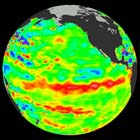El Nino might have influenced Ferdinand Magellan’s historic Pacific voyage
 Washington, May 16 : Unusual weather conditions associated with an El Nino event might be a major factor that influenced Ferdinand Magellan’s historic circumnavigation of the globe, according to a new research paper.
Washington, May 16 : Unusual weather conditions associated with an El Nino event might be a major factor that influenced Ferdinand Magellan’s historic circumnavigation of the globe, according to a new research paper.
North Carolina State University archaeologist Dr. Scott Fitzpatrick and University of Calgary researcher Dr. Richard Callaghan used computer modeling and historical data to determine the role oceanographic conditions might have played in easing his Magellan’s passage across the Pacific Ocean, though ultimately leading him over a thousand miles from his intended destination.
Magellan started his voyage from Spain in 1519 with hopes of claiming the wealth of the Spice Islands, or Moluccas, for the Spanish.
The explorer claimed the first European contact with a Pacific island culture when he landed on Guam, 1,500 miles north of the Spice Islands.
Fitzpatrick and Callaghan write in their research paper that unusually benign weather conditions associated with an El Nino event might have allowed Magellan to sail north, and persuaded him to continue in that direction to avoid starvation
Published in the journal Science, the paper says that Magellan’s voyage was perhaps not only the first to circumnavigate the globe, but apparently the earliest historical record of an El Nino event.
The paper specifically states that Magellan likely sailed around Cape Horn and directly into the tail end of an El Nino event, resulting in much smoother sailing than would normally have been the case, and allowing him to easily sail to the north along the coast of Chile.
Fitzpatrick and Callaghan also hypothesize that, after leaving the Chilean coast, Magellan might have chosen to continue on his northerly route in order to take advantage of prevailing winds and currents that had them moving at a good speed and allowed him to rest his sailors, who were by then suffering from scurvy and other maladies.
The researchers have also found evidence to support Magellan’s claim that he sailed far to the north of the Spice Islands due to concerns that the islands had no food.
Their paper says that the Pacific region appears to have been experiencing an El Nino event in 1519 and 1520, during the bulk of Magellan’s voyage, and that an El Nino is often associated with drought and accompanying famines in the area. (ANI)